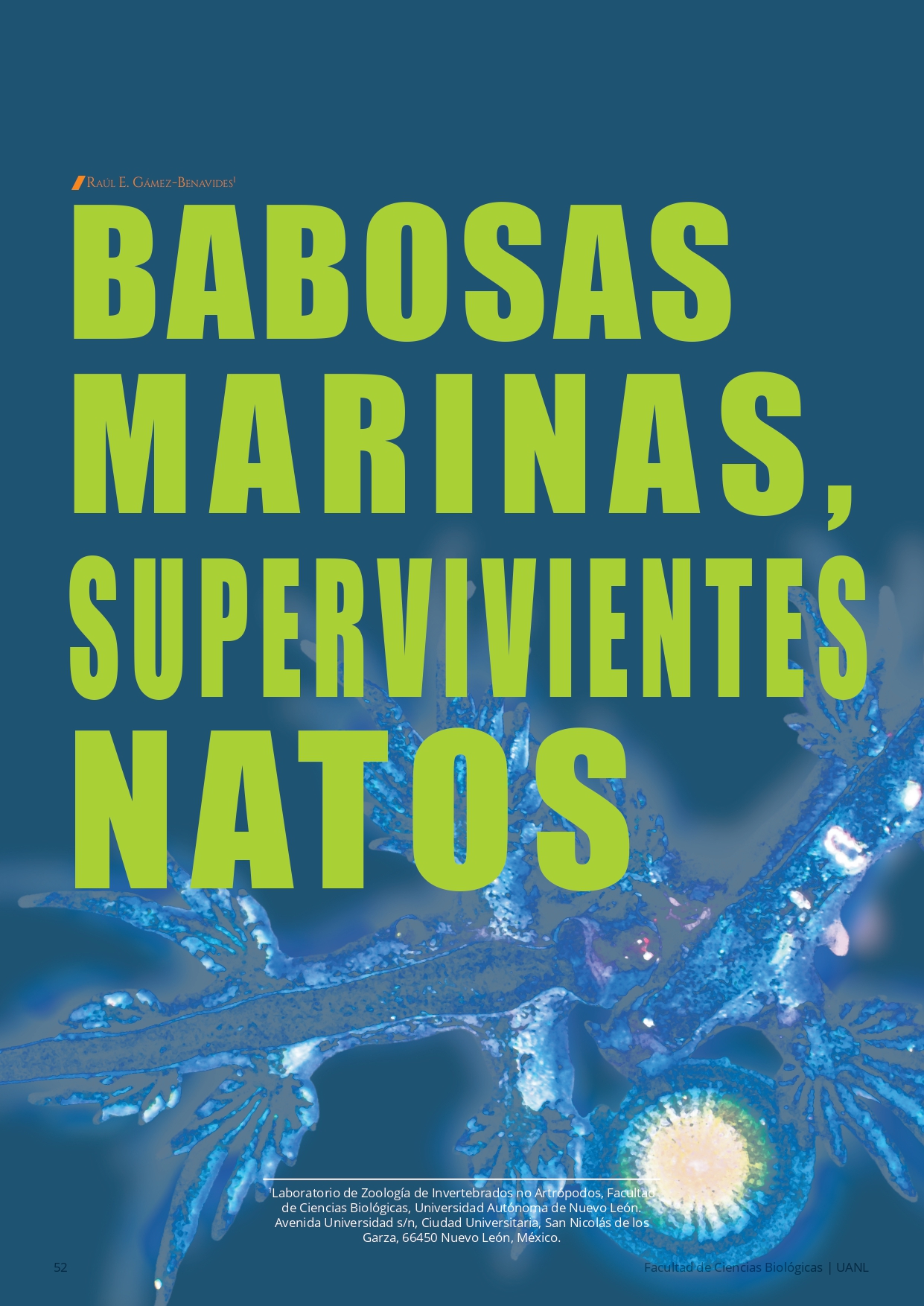Babosas marinas
supervivientes natos
DOI:
https://doi.org/10.29105/bys8.16-191Keywords:
Ecological interactions, gastropods, kleptoplasty, crypsis, aposematic colorationAbstract
Within the phylum Mollusca, there is a group commonly known as sea slugs that has evolved remarkable and distinctive survival adaptations over time. Among these, three strategies stand out: kleptoplasty, crypsis, and aposematic coloration. This discussion focuses on molluscan species such as those of the genus Elysia, which exhibit photosynthetic potential through stealing chloroplasts from algae. Additionally, it addresses the ability of these organisms to blend into their environment through camouflage, this avoiding detection by predators. Finally, certain species display bright, contrasting coloration as a warning signal to potential predators, indicative of chemical defenses or unpalatability. Furthermore, the importance of studying this group through various research topics in biology and ecology is emphasized.
Downloads
References
Aguardo, F. y Marín, A. 2007. Warning coloration associated with nematocyst-based defences in aeolidiodean nudibranchs. Journal of molluscan Studies. DOI: https://doi.org/10.1093/mollus/eyl026
Cetra, N. (2022). Abundancia, diversidad y variabilidad temporal de un ensamble de nudibranquios en un arrecife costero del Golfo San Matías. Tesis Licenciatura, Escuela Superior de Ciencias Marinas, Universidad Nacional de Comahue, 107pp.
Churchill, C.K. Valdés, Á. y Foighil, D. Ó. 2014. Molecular and morphological systematics of neustonic nudibranchs (Mollusca: Gastropoda: Glaucidae: Glaucus), with descriptions of three new cryptic species. Invertebrate Systematics, 28(2), 174-195. DOI: https://doi.org/10.1071/IS13038
Clark, K.E. Capper, A. Liu, W. Fenner, A.M. Almanza, A. Togna, G.D. Herrera, L. Johns, T. Paul, V.J. Dorrestein, P.C. Capson, T.L. y Balunas, M.J. 2021. Sequestration and cyanobacterial diet preferences in the opisthobranch molluscs dolabrifera nicaraguana and Stylocheilus rickettsi. Frontiers in Marine Science, 8, 766282. DOI: https://doi.org/10.3389/fmars.2021.766282
Galvão, H.C. 2013. Taxonomía de espécies do gênero Elysia Risso, 1818 (Mollusca: Gastropoda: Sacoglossa) do Brasil. Tesis licenciatura. Instituto Ciencias do Mar, Universidade Federal do Ceará. 135pp.
Goodheart, J.A. y Bely, A.E. 2016. Sequestration of nematocysts by divergent cnidarian predators: mechanism, function, and evolution. Invertebrate Biology. 136(1): 75-91. DOI: https://doi.org/10.1111/ivb.12154
Gorrostieta, E. Falcón, A. Aguilar, M.B. y Heimer, E.P. 2011. El sistema nervioso de los gasterópodos. Revista Digital Universitaria, 12(3), 1-9.
Hermosillo, A. Behrens, D. y Jara, E. 2006. Opistobranquios de México: guía de babosas marinas del Pacifico, Golfo de California y las islas oceánicas. (No. C/594.34 H4). México: Conabio.
Hermosillo, A. 2006. Ecología de los opistobranquios (mollusca) de Bahía de Banderas, Jalisco Nayarit, México. Tesis doctorado. Centro Universitario de Ciencias Biológicas y Agropecuarias, Universidad de Guadalajara. 163pp.
Herrera, D.F. 2021. Dieta alimenticia de la" babosa marina" Elysia diomedea, Opistobranquio (Mollusca: Gastropoda) en cautiverio. Tesis licenciatura. Facultad de Ciencias Naturales y Matemática, Universidad de El Salvador. 96pp.
Herrero, A. 2016. Biología y ecología de tres especies de nudibranquios de la familia Polyceridae, Tesis doctoral. Facultad de Ciencias del Mar, Universidad de Las Palmas de Gran Canaria. 225pp
Lopez-Martinez, R. 2018. Poderes ocultos en los colores: diversidad de babosas marinas en El Salvador. Blog RBT.
Maeda, T. Kajita, T. Maruyama, T. Y Hirano, Y. 2010. Molecular Phylogeny of the sacoglossa, with a discussion of gain and loss of kleptoplasty in the evolution of the group. The Biologican Bulletin. Volumen 219. DOI: https://doi.org/10.1086/BBLv219n1p17
Mikhlina, A. Khramova, Y. Nikitenko, E. Y Vortsenpneva, E. 2024. Radula formation and development in Limapontia senestra (Quatrefages, 1844) (Heterobranchia, Gastropoda) from the White Sea. Zoologischer Anzeiger. DOI: https://doi.org/10.1016/j.jcz.2024.07.004
Pisionero-West, N. 2012. Systematics and phylogeny of favorinus, a clade of specialized predatory nudibranchs. Tesis maestría. Faculty of San Francisco State University.
Ruppert, E.E. y Barnes, R.D. 1996. Zoología de los Invertebrados. McGraw-Hill Interamericana. Sexta Edición.
Sánchez, R. 2004. Preparación de protoplastos de Macrocystis pyrifera mediante digestión enzimática. Tesis maestría. Centro de Investigación Científica y de Educación Superior de Ensenada. 92pp.
Schmitt, V. Handeler, K. Gunkel, S. Escande, M. Menzel, D. Gould, S.B. Martin, W.F. Y Wagele, H. 2014. Chloroplast incorporation and long-term photosynthetic performance through the life cycle in laboratory cultures of Elysia timida (Sacoglossa, Heterobranchia). Frontiers in Zoology. Volume 11. DOI: https://doi.org/10.1186/1742-9994-11-5
Winters, A.E. White, A.M. Dewi, A.S. Mudianta, I.W. Wilson, N.G. Forster, L.C. Garson, M.J. y Cheney, K.L. 2018. Distribution of defensive metabolites in nudibranch molluscs. Journal of Chemical Ecology. Volume 44. DOI: https://doi.org/10.1007/s10886-018-0941-5







